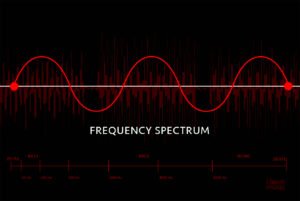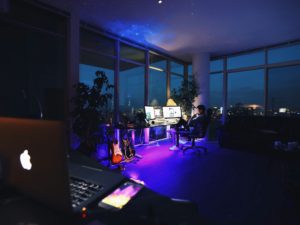Pro-s
- Compact, Smart & Affordable synthesizer.
- Multiple Digital Oscillator Modes.
- Warm Oberheim state-variable SEM Filter.
- A Cycling Envelope & Capacitative Touch Keyboard that’s usually found in high-end modular systems.
- Arpeggiator or Sequencer notes for on-the-fly performance changes.
- Easily Programmable.
Con-s
- MONO output.
- Prominent Digital sound.
- Sequencer takes some getting used to.
The Arturia Microfreak is a hybrid synthesizer that blends wavetable and other digital oscillators with analog filters. It features a unique poly-aftertouch flat keyboard, which adds controlled randomness to its sequences.
OVERVIEW

The Arturia MicroFreak is a paraphonic four-voice, compact, smart and packed synthesizer with advanced digital oscillators and a SEM analog filter that guarantees a warm sound. Combining a digital oscillator section with an Oberheim SEM-inspired multi-mode analog filter. Thus, MicroFreak offer the best of two worlds: Digital and Analog.
One of the significant USP of the Arturia MicroFreak is the inclusion of the much-loved Mutable Instruments “Plaits” module, converted into a synth. It is a complex and interesting synth that has an oscillator with 12 digital modes.
OSCILLATORS
The 12 different multiple modes of MicroFreak’s digital oscillator can be easily switched and directly controlled with the 4 dedicated knobs in the Digital Oscillator section.

The oscillator section has the following:
Type Knob
Switches between the different sound engines.
The Wave, Timbre, and Shape Controls
Refines the oscillator to suit your taste.
12 Digital oscillators on Arturia Microfreak:
- SuperWave
Detune saw, square, sine, or triangle waves to create the fat-sounding synth sounds. These are perfect for Trance and lush dreamy pads. - Harmo
As the name suggests, this is a Harmonic Oscillator which creates harmonically rich, vibrant sounds that can be shaped along with the filter. - Karplus Strong
Karplus–Strong string synthesis is a method of physical modelling synthesis. It recreates the physical characteristics of an instrument. In Physical modelling, an exciter creates vibrations in a resonator, for example, a bow position of a string instrument. - Wavetable
This sound engine emulates “Wavetable Synthesis ” which in its most simplest form consists of playing a table that contains a single cycle complex waveform with an oscillator. It is used to create complex drones & pads. - BasicWaves
This oscillator emulates two basic waveforms: the square and the sawtooth. A square wave has odd harmonics while a sawtooth has only even harmonics. - Virtual Analog
This sound engine digitally emulates classic synth waves such as Triangle, Sawtooth and Square. - Waveshaper
Wave-shaping and Wave-folding emulation. Create squelchy, aggressive, and often metallic tones. - 2-operator FM oscillator
A powerful twin-operator FM oscillator, with two sine waves which modulate each other’s phase to create interesting tones. - Formant
The Oscillator models granular synthesis, which is great for adding a textured body to sequenced rhythms. - Chords
In this emulation, the digital oscillator is transformed into a paraphonic 4-voice oscillator, capable of playing chords. - Speech
Based on Vowel and speech synthesis, the oscillator tries to emulate the human voice through consonants and vowels. - Modal
A modal resonator oscillator model that tries to imitate how sound would be amplified with the things surrounding the object, like a violin playing with a bow or a drum played with a stick, mimicking the behaviour of a real-world instrument.
“Arturia made a smart move by borrowing code for seven of the Arturia MicroFreak oscillator modes from the outstanding Plaits module by Mutable Instrument”.
FILTERS

The Oscillator here is digital, but the filter it feeds into is analogue. The analogue filter is based on the classic Oberheim state variable, an approach that is switchable between low-pass, band-pass and high-pass modes. The filter is clean and capable of self-oscillating at higher resonance settings.
Low-pass
Lets the low end through, and kill off the highs. Warm up an aggressive sound, or bring everything down to a low, ominous rumble.
Band-pass
Focus on a particular frequency band to accentuate a particular tone in your sound. The ultimate sound-shaper.
High-pass
Carve away at the muddy low-end to create bright, zingy sounds, or create tension-building rises before a pulverising drop.
“Arturia MicroFreak’s oscillator and filter parameters can be used for modulation. The synth’s modulation matrix makes this an easy task. We have seven horizontal rows that represent mod destinations. The first four are hardwired to Pitch, Wave, Timbre and Cutoff. The other three are freely assignable slots.

The five vertical columns tell us about the five available mod sources available to us in the synths: Cycling Envelope, Envelope, LFO, keyboard Pressure, and Key/Arp”
MODULATION SOURCES
Arturia MicroFreak offers three main modulators: two envelopes and two LFO’s.
One standard classic ADSR envelope, one cycling envelope, and one standard LFO. The Cycling envelope can also be used as a LFO when it is put in LOOP mode.
One standard classic ADSR envelope, one cycling envelope, and one standard LFO. The Cycling envelope can also be used as a LFO when it is put in LOOP mode.
Speaking about the envelopes, The regular Envelope (Attack, Decay/Release and Sustain) is being used for amp modulation and filter cutoff modulation. The other is a Cycling Envelope which provides you with modulation options. This is a great tool for making complex rhythms.
A standard envelope cycles through the ADSR stage only once. But here Arturia has used a cycling envelope which is usually found in high-end modular systems. A Cycling envelope re-triggers itself after the last stage is finished, hence becoming a complex LFO that is capable of creating wave shapes that cannot be generated with a standard LFO.
Cycling Envelope

In practical terms, this Cycling Envelope can create everything from slow, repeating (Attack/Release) to complex wave-shapes. Assignable to different destinations in the Modulation Matrix.
“The modulation matrix is intuitive and similar to the one on the Ableton wavetable as well as Matrixbrute”.
LFO (Low-Frequency Oscillator)
A Low-Frequency Oscillator (LFO) produces various waveforms at sub-audio frequencies.
The shape button lets you choose from one of six different waveforms: Sine, triangle, rising, sawtooth, square, random (Sample & hold) and random gliding (or smothered random).
All the modulations on the matrix are bipolar. This lets it go from negative as well as positive. Therefore, controlling the modulation target in the positive & negative range. This is one of the features that give you more sound design
CAPACITIVE KEYBOARD

The keyboard of the Arturia MicroFreak is a Buchla Easel-style 25-key capacitive keyboard. The Capacitive keyboard has copper-coloured dots that are receptors. They register touch as after-touch or as velocity. Capacitive sensors are proximity sensors that detect nearby objects by their effect on the electrical field created by the sensor.
This human interface device allows the user to connect with the instrument by sensing pressure. So, it senses both the firmness of the fingers and the surface area of the skin. The keyboard is a PCB flat strip that responds to the amount of surface area one’s fingers cover. We can adjust its responsiveness from the utility menu.

ARP/SEQ
For making the whole process of sound design more fun, Arturia MicroFreak features an Arpeggiator.
An arpeggiator helps with melodic movements. Engage the Arpeggiator by pressing Arp/SEQ button. The Arpeggiator section is pretty easy to use with the addition of the Eight touchpad icons that sit above the keyboard.

The first one lets you hold notes for extended play. Use the next four: Up, Order, Random and Pattern, to operate the Arpeggiator or Sequencer. The next two, abstractly named Spice and Dice, effectively shorten or lengthen Arpeggiator or Sequencer notes for on-the-fly performance changes.
IN CONCLUSION
It’s a little FREAKY!
Unlike Arturia’s previous Brute range, the Arturia MicroFreak is way smaller. It becomes pretty clear from the design that Arturia didn’t want to make a conventional synth. They call it an ‘algorithmic’ synthesizer’. MicroFreak’s core is its advanced digital oscillator & classic SEM-inspired multi-mode analogue filter.
The MicroFreak is a good value-for-money synth. It gives you inspiring ways through its modulation capabilities to make sound design a fun process.
It might not be that appealing to conventional synth players but newbies looking for interesting sounds will definitely love its playfulness and randomness.
Read about the 2019 Arturia India Meet-Up with Patrice Martin
Explore more synths with us:
- Moog:
- Arturia
- Microfreak
- MiniBrute
- Korg
- Waldorf



















